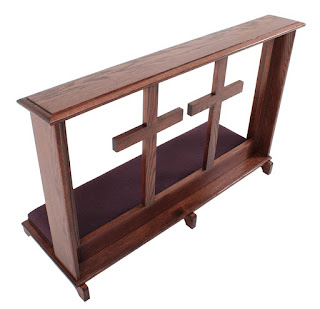Consistently throughout the Bible, God calls us to pray. There
are numerous reasons for prayer, but the simple desire to communicate with God
should drive us to our knees. In early churches, worshipers would kneel on the
floor of the church or on the ground, depending on the building. However, in many
instances, worshipers would demonstrate humility by lying with their face to
the ground.
The ultimate position of humbleness is to lie prostrate in
prayer to the Lord. Throughout the Bible, in times of crisis and need or in
thanksgiving to God, worshipers would fall on their face and pray. “And Abram fell
on his face: and God talked with him, saying, As for me, behold, my
covenant is with thee, and thou shalt be a father of many
nations” (Genesis 17:3). “And it came to pass, when he was in a certain
city, behold a man full of leprosy: who seeing Jesus fell on his face,
and besought him, saying, Lord, if thou wilt, thou canst make me clean” (Luke
5:12).
 Prayer position is important in that it is an outward
manifestation of what we are feeling. A common Christian prayer posture is to
bow your head, whether seated or standing. But how many of us have come before
God in a moment of crisis or during a stressful situation beyond our control
and literally hit our knees or fell on our face before Him? Our body language
echoes the woes of our hearts and shows reverence to whom we speak. This is why
many churches offer kneeling furniture, even if kneeling is not part of the
worship service.
Prayer position is important in that it is an outward
manifestation of what we are feeling. A common Christian prayer posture is to
bow your head, whether seated or standing. But how many of us have come before
God in a moment of crisis or during a stressful situation beyond our control
and literally hit our knees or fell on our face before Him? Our body language
echoes the woes of our hearts and shows reverence to whom we speak. This is why
many churches offer kneeling furniture, even if kneeling is not part of the
worship service.
Kneelers
are an important staple in many church sanctuaries. Some churches – especially
Catholic churches - have pews that contain built-in kneelers. These kneelers
are used throughout the service during the Catholic Mass ritual. Confessional
booths in Catholic churches and in some Anglican churches might also contain
kneelers.
You might see altar rails with built-in kneelers in many
Catholic, Anglican, Lutheran, and Methodist churches. Within the Catholic
Church, church members can kneel and receive communion from their priest. In
the Lutheran Church, altar rails are sometimes accessible to members who wish
to give confession to their pastor. Altar rails are used in some Methodist
churches as a means of receiving communion and during confirmation, in which
congregation members seek to become members of the church after a confession of
faith.
“Wherefore God also hath highly exalted him, and given him a
name which is above every name: That at the name of Jesus every knee should
bow, of things in heaven, and things in
earth, and things under the earth; And that every
tongue should confess that Jesus Christ is Lord, to the glory
of God the Father” (Philippians 2:9-11).
In Matthew, Jesus describes Himself as “Meek and lowly in
heart” (Matthew 11:29). If this is the character of our Lord and Savior, and if
we are to try to model our behavior after Him, then seeking a meek position
during our prayer time, when possible, should be a goal.




0 comments:
Post a Comment